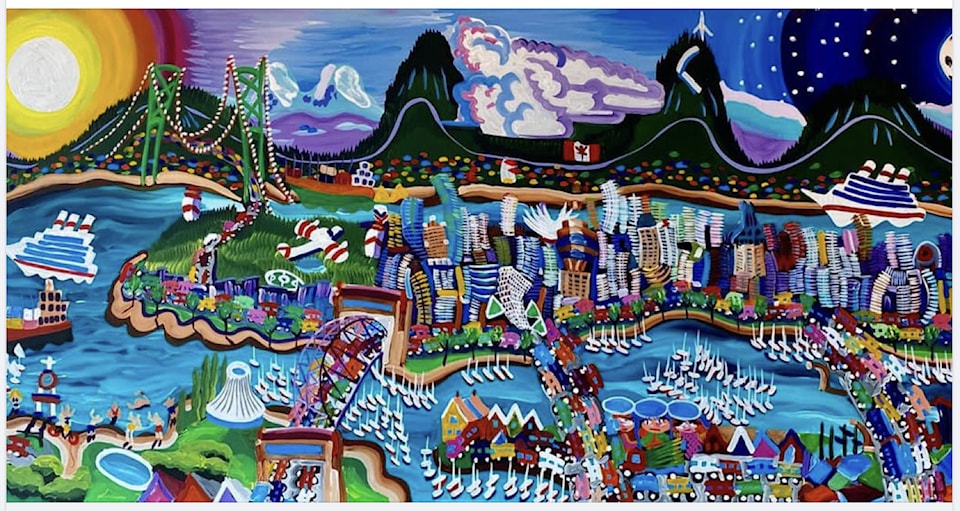John Ferrie has always seen the world in technicolour. The Vancouver-born artist’s studio shelves are teeming with vividly coloured crayons and bottles of paint, but John admits he first sketches every work in pencil, because it has to work as a drawing before he’ll pull out the paintbrushes. After that, he says, painting is “just production time.”
John’s productions can be prolific in scale – he has sold thousands of paintings during his more than 30-year career. He doesn’t title them, as he tends to paint in series, but early on, he used to name paintings after songs he was listening to at the time, just to catalogue the work.
John’s signature is casting Vancouver’s cityscapes and architecture in technicolour, depicted in dramatic curves and sinewy shapes. He remembers picking up the thread when coming across the Burrard Street bridge and looking up at the Sheraton Wall Centre at sunset, seeing all the colours radiating off the building in the sunlight and thinking how magnificent it was. He wanted to capture that on the canvas.
“The thing about my work is I can’t draw a straight line – so I don’t. And I just add as much colour as I want,” John says, describing his art from his east side studio, where the workspace seems in sync with the living space.
As a child, John painted anything he could, starting, he thinks, at about two years old. He struggled in school, was diagnosed as dyslexic, and was referred to remedial reading. His parents gave him a paint set to encourage creativity, and he says the trajectory of his life changed in grade seven when he was introduced to the art department.
Growing up, he always only wanted art supplies, on which he spent all his allowance.
By grade nine, he was already applying to art schools.
John studied at Emily Carr University of Art + Design during the same time as Douglas Coupland and graduated in 1988. He has always loved the artwork of Andy Warhol and has tried to emulate the pop art genre. He admires North Vancouver’s Ross Penhall – more than any other living artist, he says. When the two met, Ross signed a paintbrush for John and handed it over.
“I felt like Harry Potter – like I had my magic wand now,” John recalls.
A career breakthrough came in 1999, when John, moonlighting as a waiter, was serving hors d’oeuvres at a party when he spotted television personality Vicki Gaberau. He wanted to go on her show to talk about his art, so he put down the tray of crab puffs he was carrying and cornered her.
After that conversation, John called Vicki’s show’s producers relentlessly, telling them, “this will make jolly good television.”
It worked: John appeared on the show the same year.
Jacqui Cohen was the first to pick John’s work up commercially and began showcasing his paintings at a Face the World Foundation event, one of Vancouver’s most iconic annual charities. He still donates a painting to her cause every year; one netted $20,000 for the charity.
The onset of the pandemic in 2020 jolted John, and he pivoted by putting off his planned showing of his latest collection, Ultra, instead posting photographs online. He wondered and worried if the online showing would be a flop, but says it turned out to be a success, with thousands dialing in and sharing the event “all over the world.”
That was at the very beginning of a lockdown that would see the world sent home, which, for John, turned out to be creative serendipity.
His pandemic series, aptly titled Covid 19, saw a departure from his signature technicolour work, as dark skies, permeated by swirling orbs of white moon and punctuated by a smattering of stars, appear on the series’ canvases.
John says the appearance of the night skies marked a literal reflection of the fact that during lockdown, he was filling his days caring for his elderly parents – whom he didn’t want leaving their house – shopping for supplies and making sure they were well-stocked and safe at home.
“A lot of my painting started happening at night, which was a really different gear for me. I communicated with my family a great deal, which was important to me, but when it came to getting painting done, I couldn’t get to my paints until the end of the day.”
John relates how he saw the full moons, and all the things that happen in a night sky, and wanted to work that beauty onto his cityscapes.
“I wanted the paintings to be more dramatic, with lights and uplighting, and found I really enjoyed communicating what I was doing. There was an eerie calm to the world.”
John says the dark skies depicted were also an acknowledgement of the Black Lives Matter movement, which sparked international protests against racialized violence in city streets.
“I wanted to make sure that I was being respectful to the cause. It was an incredible time. I thought it was phenomenal, the statements people were making. And as an artist, I wanted to capture those moments, just as a mirror being held up to society. It was unsettling, but also empowering.”
John worried about the reaction to the series, which turned out to be overwhelmingly positive.
He is candid about resolving to accept the percentage of the population that won’t like his work but refuses to be daunted.
“I want to be in my studio, painting all day long and working on communicating the vocabulary of being an artist. You can’t live in fear. You paint past your fears and your tears.”
This story appeared in the November issue of Boulevard Vancouver.



